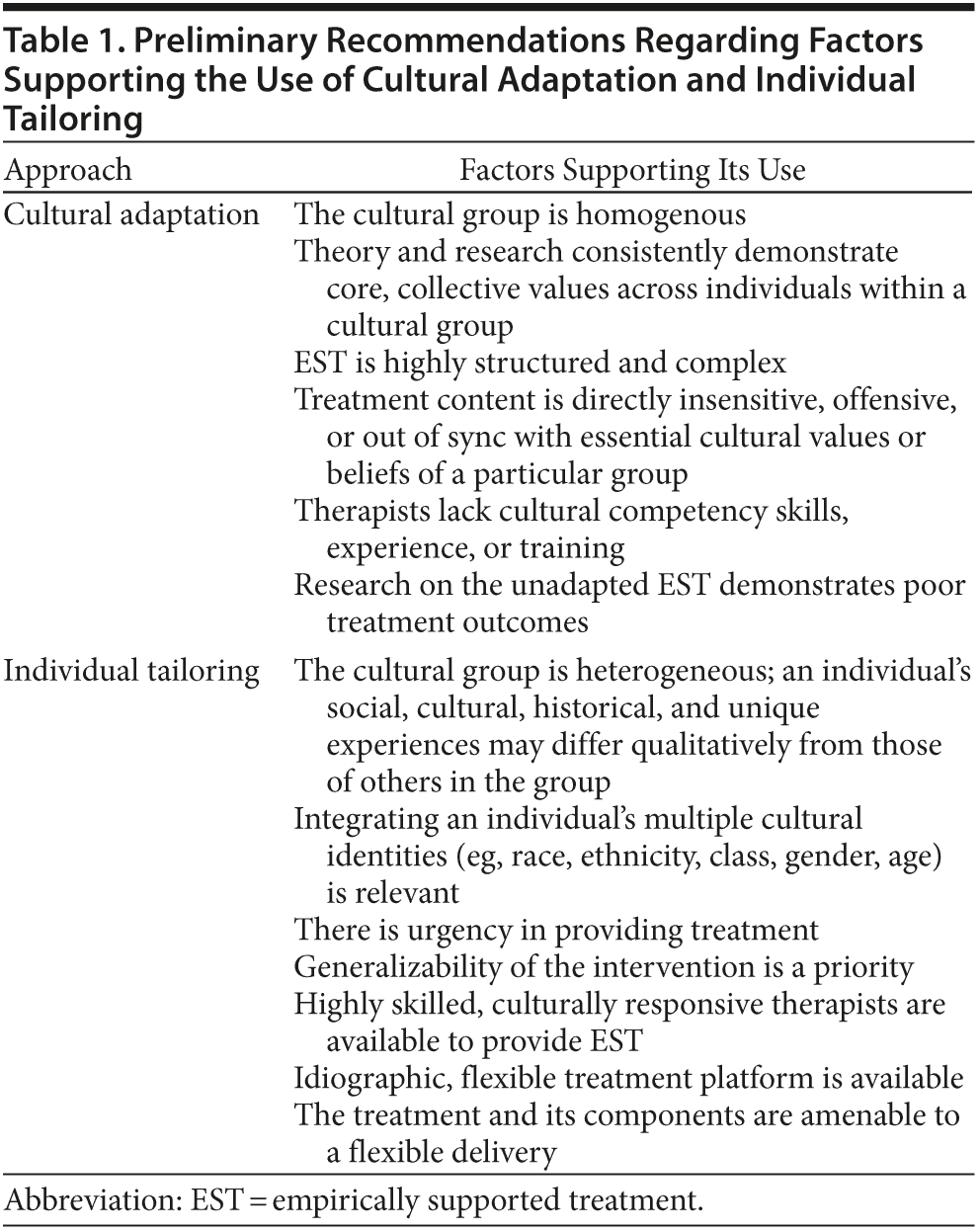Cultural Adaptation and Individual Tailoring: Two Approaches to the Development of Culturally Responsive Treatment
To the Editor: Multiple initiatives targeting mental health disparities in ethnic minorities underscore the need for culturally responsive, empirically supported treatments (ESTs).1 We highlight 2 frameworks for the development of these ESTs: cultural adaptation and individual tailoring. The most common is cultural adaptation, which manualizes changes to EST content according to core values of a specific group while preserving an intervention’s central tenets. A newer, yet promising approach is individual tailoring. This approach involves the flexible use of ESTs to accommodate personal values case by case and without global, culturally specific modifications (see Table 1).
Use of cultural adaptation is optimal if clinical research consistently identifies common group values and/or if an unadapted EST demonstrates poor outcomes within specific groups. Cultural adaptation may be appropriate if an EST is highly structured and complex, limiting the feasibility of in-session adaptations. Moreover, cultural adaptation is necessary if an EST is insensitive to a group’s values or if mental health providers lacking cultural competence deliver the EST. However, cultural adaptation is associated with logistical and feasibility barriers.2 Barriers include lengthy programmatic treatment development procedures and the fact that no cultural adaptation will address the unique needs of all members of a particular group.
In contrast to cultural adaptation, individual tailoring may be best used with populations demonstrating high within-group heterogeneity. Due to its idiographic focus, individual tailoring recognizes intricacies associated with the intersection of multiple cultural identities. It allows the therapist to integrate salient and meaningful elements of a multidimensional identity for each client. This is an emerging framework consistent with current multicultural approaches3 that has received recent empirical support.4,5 In line with this flexible, client-centered approach, individual tailoring allows use of established ESTs, eliminating delays between seeking and receiving therapy. Altogether, individual tailoring promotes detachment from cultural stereotypes, increases utilization of existing treatments, supports generalizability, and is efficient. As with cultural adaptation, individual tailoring utilization carries limitations. Therapists may need sophisticated skills in cultural responsiveness and/or an in-depth understanding of the theoretical underpinnings of the EST prior to in-session tailoring. Moreover, individual tailoring is restricted to interventions that are streamlined and amenable to flexible provision of their treatment components.
An example highlighting the unique strengths of cultural adaptation and individual tailoring involves 2 separate uses of behavioral activation to treat depression among Spanish-speaking Latino individuals. Taking a cultural adaptation approach, Kanter and colleagues6 translated and modified a highly directive and comprehensive behavioral activation manual7 that had not been evaluated in published studies with this minority community. Cultural adaptation was based on the argument that the original behavioral activation manual was not "sensitive to Latino values or experiences."6 The researchers identified common themes and suggestions for cultural adaptation, including the integration of family members into treatment and the removal of abstract treatment aspects in favor of a simplified rationale. Particularly relevant to their use of cultural adaptation, the investigators reported considerable sample homogeneity regarding participants’ country of origin, age, family size, and income. Results indicated significant improvements in depression symptomatology, but also showed retention issues.
Noting the promising reductions in depressive symptoms in this behavioral activation trial,6 we conducted a second study but chose a different strategy to improve retention and apply this work to a heterogeneous sample. Taking an individual tailoring approach, we utilized a direct Spanish translation of the Brief Behavioral Activation Treatment for Depression (BATD),8 a 10-session version of behavioral activation with no other adaptations. We deemed an individual tailoring appropriate given the practical focus of the BATD on developing individualized values and goals for each client. Results revealed significant reductions in depressive symptomatology, with clients attending 88% of sessions (A. Collado-Rodriguez, MS; S. D. Castillo, BS; F. Maero, BS; et al; manuscript submitted; 2013)..
Although preliminary, these results indicate strengths of a structured cultural adaptation and a flexible individual tailoring. Together, both approaches hold great promise in advancing the field of efficacious treatments among ethnic minority communities.
References
1. American Psychiatric Association, Steering Committee to Reduce Disparities in Access to Psychiatric Care. Reducing mental health disparities for racial and ethnic minorities: a plan of action. Updated December 2004. http://www.psychiatry.org/File%20Library/Practice/Diversity%20OMNA/Diversity%20Resources/Action-Plan_Reducing-MH-Disparities2004.pdf. Accessibility verified June 26, 2013.
2. Castro FG, Barrera M Jr, Holleran Steiker LK. Issues and challenges in the design of culturally adapted evidence-based interventions. Annu Rev Clin Psychol. 2010;6(1):213-239. PubMed doi:10.1146/annurev-clinpsy-033109-132032
3. Gallardo ME, McNeill BW, eds. Intersections of Multiple Identities: A Casebook of Evidence-Based Practices With Diverse Populations. London, UK: Routledge; 2009.
4. Gil AG, Wagner EF, Tubman JG. Culturally sensitive substance abuse intervention for Hispanic and African American adolescents: empirical examples from the Alcohol Treatment Targeting Adolescents in Need (ATTAIN) Project. Addiction. 2004;99(suppl 2):140-150. PubMed doi:10.1111/j.1360-0443.2004.00861.x
5. Yadavaia JE, Hayes SC. Acceptance and commitment therapy for self-stigma around sexual orientation: a multiple baseline evaluation. Cognit Behav Pract. 2012;19(4):545-559. doi:10.1016/j.cbpra.2011.09.002
6. Kanter JW, Santiago-Rivera AL, Rusch LC, et al. Initial outcomes of a culturally adapted behavioral activation for Latinas diagnosed with depression at a community clinic. Behav Modif. 2010;34(2):120-144. PubMed doi:10.1177/0145445509359682
7. Martell CR, Addis ME, Jacobson NS. Depression in Context: Strategies for Guided Action. New York, NY: W W Norton; 2001.
8. Lejuez CW, Hopko DR, Acierno R, et al. Ten year revision of the brief behavioral activation treatment for depression: revised treatment manual. Behav Modif. 2011;35(2):111-161. PubMed doi:10.1177/0145445510390929
Author affiliations: Department of Psychology, University of Maryland, College Park.
Potential conflicts of interest: None reported.
Funding/support: None reported.
Published online: September 5, 2013.
Prim Care Companion CNS Disord 2013;15(5):doi:10.4088/PCC.13l01540
© Copyright 2013 Physicians Postgraduate Press, Inc.






